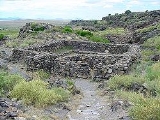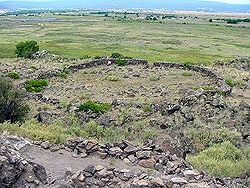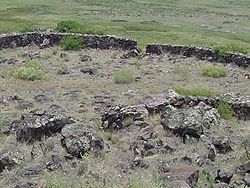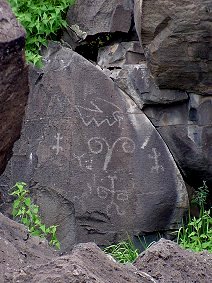
Casa Malpais
Encyclopedia
Casa Malpaís is an ancient pueblo people archaeological site located near the town of Springerville, Arizona
. The site is a nationally recognized archaeological site and was declared a National Historic Landmark
in 1964.
to the Pueblo IV Era
. It is one of the latest dated Mogollon sites. The name Casa Malpaís means House of the Badlands, which was given to the site by early Basque
sheepherders in reference to the surrounding volcanic lava field. The Springerville volcanic field
contains over 400 volcanoes within a fifty mile radius of Springerville, making it the third largest volcanic field in the continental United States
.
Unique and unusual features characterize the site. The Great Kiva
, painstakingly constructed of volcanic rock, is the centerpiece. A steep basalt
staircase set into a crevice of the high basalt cliff wall leads to the top of the mesa.
Both the Hopi
and Zuni Indian tribes still consider Casa Malpaís a sacred ancestral place.
The site is at an elevation of 7,000 feet and the pueblo is perched atop terraces on front of basalt cliffs. These cliffs were formed from lava flow from an ancient volcano.
Around 1240 A.D., a 60 room pueblo, solar calendar, and Great Kiva were built by the people. The site was believed to be abandoned by 1350 A.D.

The summer solstice
sunset casts a shadow across a pit outside the west opening, through the west opening, and onto the inside of the east wall just north of the southeast opening.
The winter solstice
sunrise is marked by sunlight coming over the southeast opening and hitting an alter on the inside of the west wall where the wall bends, now marked with a sandstone slab with the letter A.
 The winter solstice sunset emanates from a notch just over the west edge of Pole Knoll, located about 24 kilometers southwest of Casa Malpaís, and it passes over the south opening, over the east opening, through a boulder field above the calendar, and lands upon a bearclaw petroglyph on the cliff face.
The winter solstice sunset emanates from a notch just over the west edge of Pole Knoll, located about 24 kilometers southwest of Casa Malpaís, and it passes over the south opening, over the east opening, through a boulder field above the calendar, and lands upon a bearclaw petroglyph on the cliff face.
The south opening is a little over a meter wide and the walls are offset to allow the Spring Equinox sunrise to pass through the offset in the walls across the southeast opening and through the south opening without hitting the inside of either south wall until well after sunrise. A white sandstone slab at the site marked with the letter S indicates which direction is south.
, visited a site at "El Valle Redondo on the Colorado Chiquito
", and was impressed by what he termed "the fissure type pueblo
" he found there. In his journal he sketched dry masonry bridging fissures, upon which the pueblo is constructed.

Springerville, Arizona
Springerville is a town in Apache County, Arizona, United States within the White Mountains. Its postal ZIP code is 85938. According to 2006 Census Bureau estimates, the population of the town is 1,956.Springerville sits at an elevation of 6,974 feet...
. The site is a nationally recognized archaeological site and was declared a National Historic Landmark
National Historic Landmark
A National Historic Landmark is a building, site, structure, object, or district, that is officially recognized by the United States government for its historical significance...
in 1964.
Description
Casa Malpaís was built around 1260 A.D. and was inhabited until about 1400 A.D., meaning that the site dates from the Pueblo IIIPueblo III Era
The Pueblo III Era, AD 1150 to 1350, was the third period, also called the "Great Pueblo period" when Ancient Pueblo People lived in large cliff-dwelling, multi-storied pueblo, or cliff-side talus house communities...
to the Pueblo IV Era
Pueblo IV Era
The Pueblo IV Era, was the fourth period of ancient pueblo life in the American Southwest. At the end of prior Pueblo III Era, Anasazi living in the Colorado and Utah regions abandoned their settlements and migrated south to the Little Colorado River and Rio Grande River valleys...
. It is one of the latest dated Mogollon sites. The name Casa Malpaís means House of the Badlands, which was given to the site by early Basque
Basque people
The Basques as an ethnic group, primarily inhabit an area traditionally known as the Basque Country , a region that is located around the western end of the Pyrenees on the coast of the Bay of Biscay and straddles parts of north-central Spain and south-western France.The Basques are known in the...
sheepherders in reference to the surrounding volcanic lava field. The Springerville volcanic field
Springerville volcanic field
Springerville volcanic field is a monogenetic volcanic field located in east-central Arizona, USA. The field consists of 405 discrete vents covering approximately and is the third largest such field in the continental United States, only the San Francisco volcanic field and Medicine Lake volcanic...
contains over 400 volcanoes within a fifty mile radius of Springerville, making it the third largest volcanic field in the continental United States
United States
The United States of America is a federal constitutional republic comprising fifty states and a federal district...
.
Unique and unusual features characterize the site. The Great Kiva
Kiva
A kiva is a room used by modern Puebloans for religious rituals, many of them associated with the kachina belief system. Among the modern Hopi and most other Pueblo peoples, kivas are square-walled and underground, and are used for spiritual ceremonies....
, painstakingly constructed of volcanic rock, is the centerpiece. A steep basalt
Basalt
Basalt is a common extrusive volcanic rock. It is usually grey to black and fine-grained due to rapid cooling of lava at the surface of a planet. It may be porphyritic containing larger crystals in a fine matrix, or vesicular, or frothy scoria. Unweathered basalt is black or grey...
staircase set into a crevice of the high basalt cliff wall leads to the top of the mesa.
Both the Hopi
Hopi
The Hopi are a federally recognized tribe of indigenous Native American people, who primarily live on the Hopi Reservation in northeastern Arizona. The Hopi area according to the 2000 census has a population of 6,946 people. Their Hopi language is one of the 30 of the Uto-Aztecan language...
and Zuni Indian tribes still consider Casa Malpaís a sacred ancestral place.
The site is at an elevation of 7,000 feet and the pueblo is perched atop terraces on front of basalt cliffs. These cliffs were formed from lava flow from an ancient volcano.
Around 1240 A.D., a 60 room pueblo, solar calendar, and Great Kiva were built by the people. The site was believed to be abandoned by 1350 A.D.

The Observatory
The site includes the ruins of an ancient astronomical observatory. The observatory is circular with five openings, and is approximately 26 meters in diameter. Four of the openings are connected with solstices, equinoxes, or both, while the fifth opening indicates true north by aligning with a pointed foundation stone at the center of the south wall.The summer solstice
Summer solstice
The summer solstice occurs exactly when the axial tilt of a planet's semi-axis in a given hemisphere is most inclined towards the star that it orbits. Earth's maximum axial tilt to our star, the Sun, during a solstice is 23° 26'. Though the summer solstice is an instant in time, the term is also...
sunset casts a shadow across a pit outside the west opening, through the west opening, and onto the inside of the east wall just north of the southeast opening.
The winter solstice
Winter solstice
Winter solstice may refer to:* Winter solstice, astronomical event* Winter Solstice , former band* Winter Solstice: North , seasonal songs* Winter Solstice , 2005 American film...
sunrise is marked by sunlight coming over the southeast opening and hitting an alter on the inside of the west wall where the wall bends, now marked with a sandstone slab with the letter A.

The south opening is a little over a meter wide and the walls are offset to allow the Spring Equinox sunrise to pass through the offset in the walls across the southeast opening and through the south opening without hitting the inside of either south wall until well after sunrise. A white sandstone slab at the site marked with the letter S indicates which direction is south.
Discovery
The first visit to Casa Malpaís by a professional anthropologist was in 1883, when Frank Cushing, an anthropologist living at Zuni Pueblo, New MexicoZuni Pueblo, New Mexico
Zuni Pueblo is a census-designated place in McKinley County, New Mexico, United States. The population was 6,367 at the 2000 census...
, visited a site at "El Valle Redondo on the Colorado Chiquito
Little Colorado River
The Little Colorado River is a river in the U.S. state of Arizona, providing the principal drainage from the Painted Desert region. Together with its major tributary, the Puerco River, it drains an area of about in eastern Arizona and western New Mexico...
", and was impressed by what he termed "the fissure type pueblo
Pueblo
Pueblo is a term used to describe modern communities of Native Americans in the Southwestern United States of America. The first Spanish explorers of the Southwest used this term to describe the communities housed in apartment-like structures built of stone, adobe mud, and other local material...
" he found there. In his journal he sketched dry masonry bridging fissures, upon which the pueblo is constructed.
Casa Malpais Visitor Center and Museum
The Casa Malpais Visitor Center and Museum'is located on Main Street in Springerville, Arizona. The museum displays artifacts found at Casa Malpais and offers guided tours of the site that originate at the museum.

